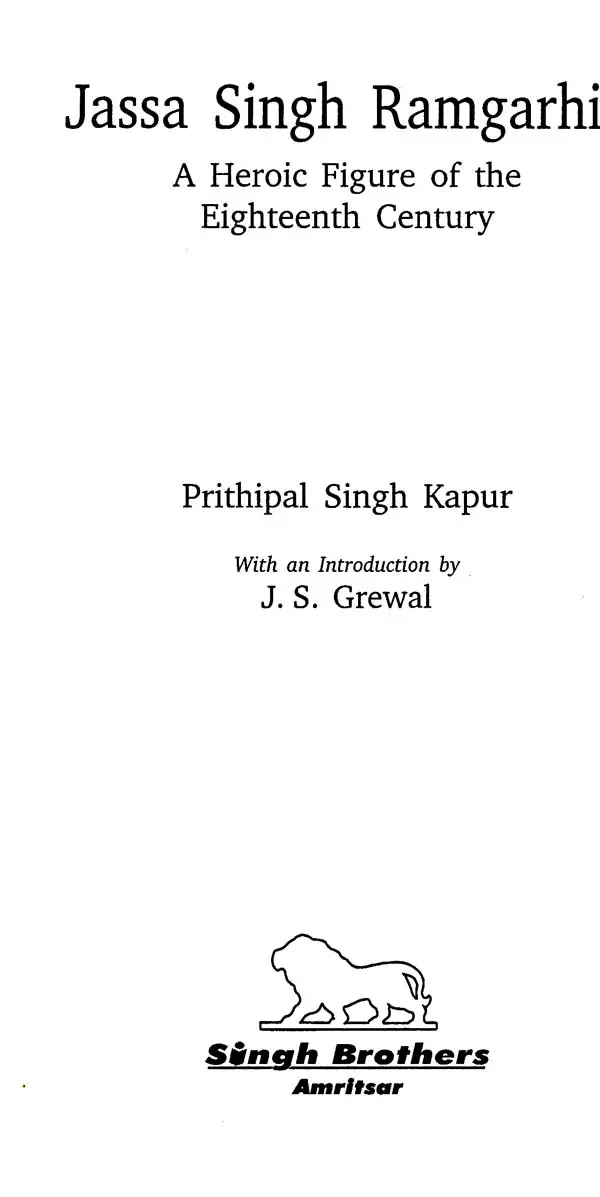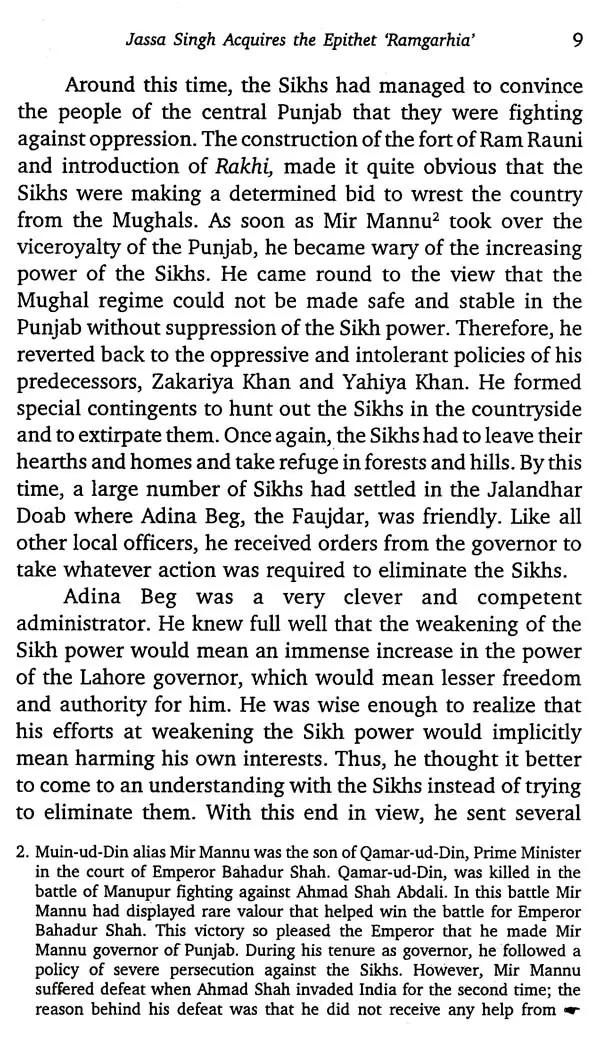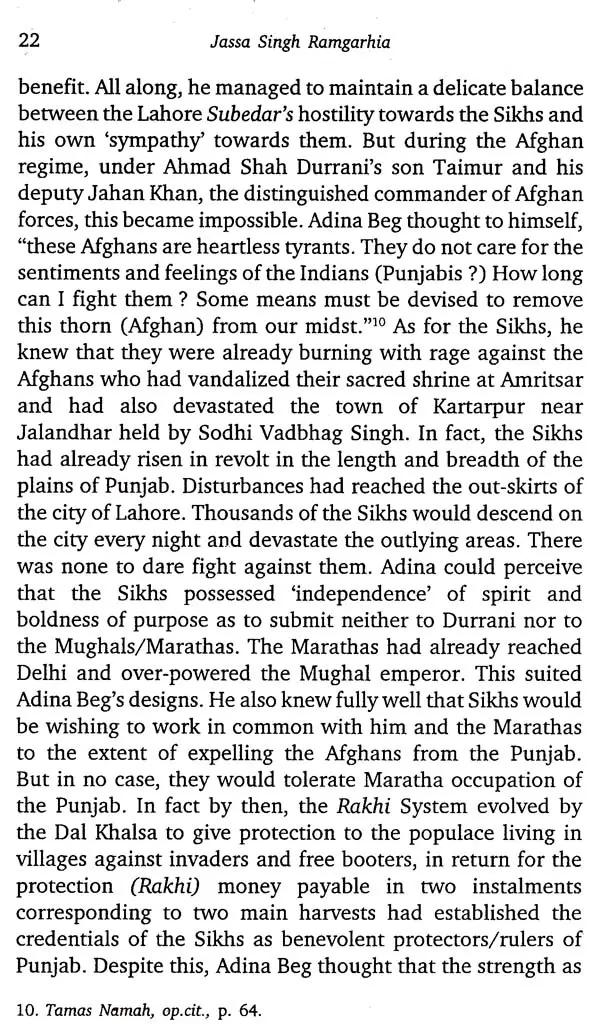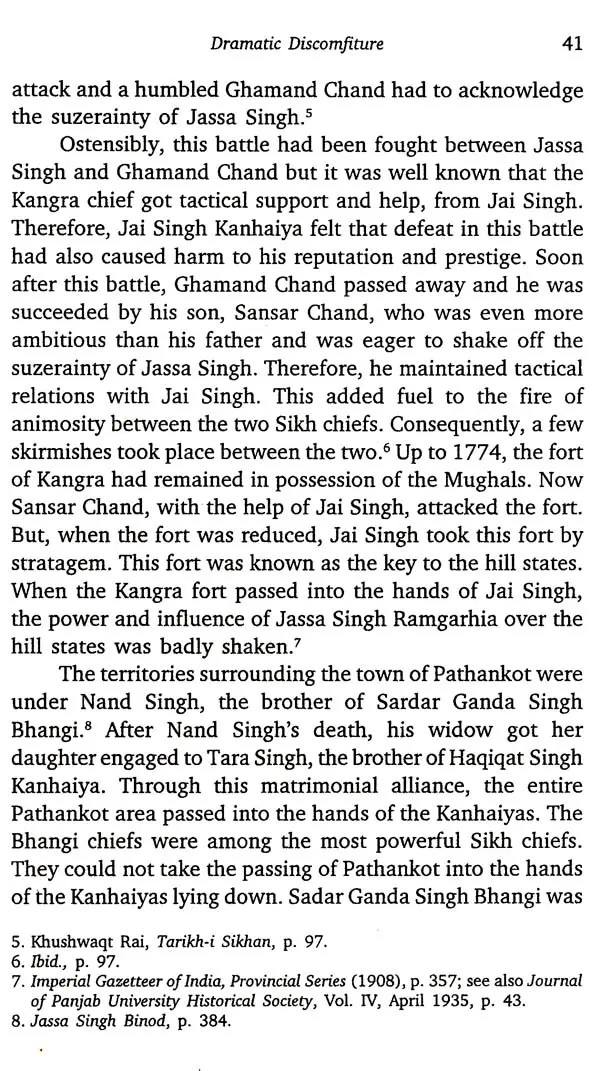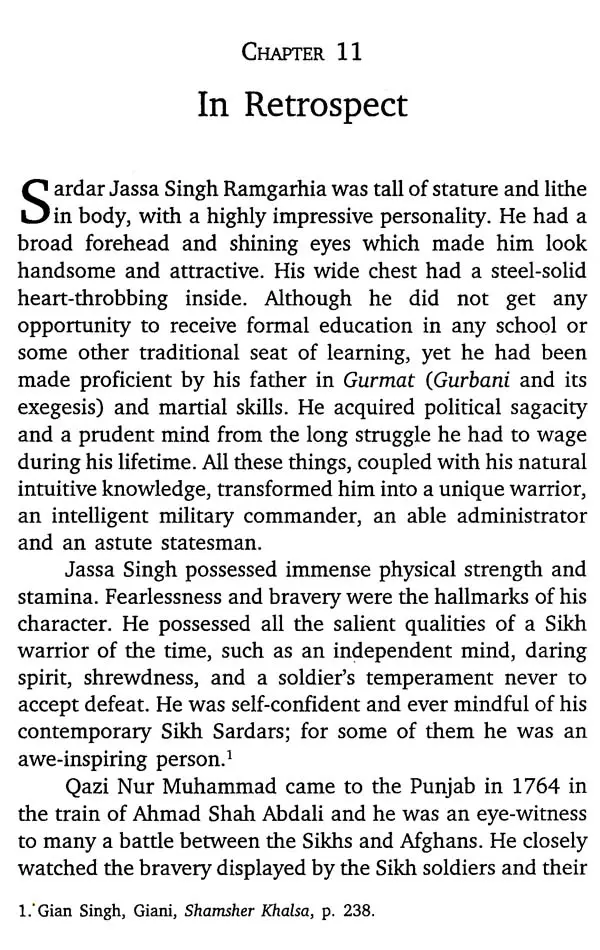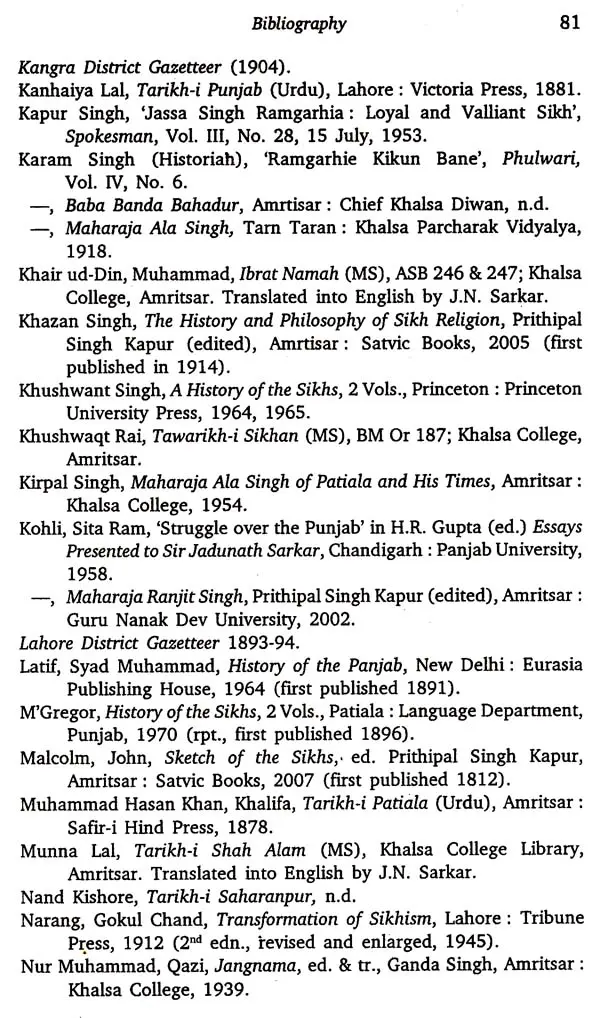
Jassa Singh Ramgarhia- A Heroic Figure of the Eighteenth Century
Book Specification
| Item Code: | UAZ639 |
| Author: | Prithipal Singh Kapur |
| Publisher: | Singh Brothers, Amritsar |
| Language: | English |
| Edition: | 2012 |
| ISBN: | 8172054777 |
| Pages: | 90 |
| Cover: | HARDCOVER |
| Other Details | 8.50 X 5.80 inch |
| Weight | 280 gm |
Book Description
JASSA SINGH RAMGARHIA (1723-1803) was a prominent leader of the Sikh confederacy (Dal Khalsa) that came to be organized during the mid-eighteenth century (precisely late forties). He was chief of the Ramgarhia Mist which finds mention in the rating of strength only next to the Ahluwalias and the Bhangis. It held the Ramgarh fort (Amritsar), conquered vast territories on both the sides of river Beas, led forays into the Kangra hills, humbled the Kangra Chief, subdued most of the hill rajas of the Jalandhar Doab and exacted tribute from them. Jassa Singh Ramgarhia was not only a great warrior but was also one of those few Sikh chiefs who comprehended the teachings of the great Gurus and strived to live up to them.
This book, written in a lucid style, based on the contemporary sources, presents an authentic account of the life of this great hero. The biographer has tried to look with empathy at the eventful life of this heroic figure in order to make sense of the diverse elements of evidence in terms of the growing personality and stature of Jassa Singh Ramgarhia from his early age to the end of his life. The attitude of the author remains both critical and sympathetic throughout. This study adds a new dimension to our understanding of the different phases of history of the Sikhs during the eighteenth century.
PRITHIPAL SINGH KAPUR, a well known educationist and historian, has been the Pro Vice- Chancellor of Guru Nanak Dev University, Amritsar and Director of Punjab State University Text Book Board, Chandigarh. Besides, he served as Editor-in-Chief of the Encyclopaedia of Sikhism at Punjabi University, Patiala. He also remained a member of the Academic Council of Tagore's Shanti Niketan (West Bengal). He has authored/edited more than a score of books on Sikh history/ history of Punjab including Jassa Singh Ramgarhia (Pbi.), Punjab Da Itihas (1469-1799) (Pbi.), Master Tara Singh: Itihasak Pakh Ton (Pbi.), The Khalsa (Conjoint with Dharam Singh), Main Currents of Freedom Struggle in Punjab, and edited works such as Sewa Ram Singh's The Divine Master: Life & Teachings of Guru Nanak, Sikhism in the Third Millennium (Seminar Papers), Maharaja Ranjit Singh's Coronation Commemorative Volume.
was studying in the 10th class and was due to appear in Ithe matriculation examination of the Panjab University, Lahore, when fateful events of the year 1947 forced our family to leave Gujranwala (now in Pakistan) for what was then described as 'the rest of India' in the transfer orders of my father who was serving in a central government department. It took some time for the whirlwind of partition to subside to enable me to think of appearing in the matriculation examination of the newly established East Panjab University, Solan (now Himachal Pradesh). Despite the stresses and strains, I could pass the examination in first class and my father visualized a bright future for me by getting me admitted to the commerce course for graduation. I was pushed to join the Sri Ram College of Commerce at Delhi; then housed in a big bungalow in Darya Ganj, sometime in September-October 1948. In the courses of reading for the Pre-University class, there was a paper in history, prescribing the study of the rise and fall of four major civilizations: Greek, Egyptian, Mesopotamian and the Indus Valley. Mr. Amba Parshad (later eminent historian, Dr Amba Parshad, Professor and Head of History Department at Delhi University) was then working as a Lecturer in History in our college. One day, while returning answer sheets of a terminal test in the class, he said to me, 'Do you feel comfortable with the commerce course?' I got perplexed but my teacher went on to add 'You will do well in history, if you pursue a career in this subject'. This judgement of my teacher marked a turning point in my life. After three years at the Sri Ram College of Commerce, I was on my way back to Jalandhar to join B.A. (Honours in History) and then M.A. (History) at Phagwara. Professor Kirpal Singh Narang (formerly a popular Lecturer in History at Guru Nanak Khalsa College, Gujranwala) was then principal at Phagwara. He was a widely known and respected teacher for Post- Graduate classes in the subject of history. Soon, I earned his patronage. He instilled in me the idea of undertaking research in Sikh/Punjab history, which had been by then introduced in the courses of reading for the undergraduate and postgraduate classes. He even suggested Jassa Singh Ramgarhia (A Biographical Study) as the topic. I was further inspired and encouraged by my uncle S. Kirpal Singh (now a renowned Sikh historian) who had by then joined as Sikh history Research Scholar, at Khalsa College, Amritsar.
It was under such circumstances that I got motivated to undertake research on Jassa Singh Ramgarhia. As I delved deep into the subject, I found that the subject of my research had enough to inspire. Hard work, perseverance, consistency and determination were the peculiar traits of the personality of Jassa Singh Ramgarhia. I met Dr Hari Ram Gupta at Hoshiarpur where several Departments of Panjab University were then located. He gave me enough time to discuss the subject and told me that quite a few Sikh Sardars of the eighteenth century deserved biographical study. As a result, Jassa Singh Ramgarhia became the subject of my dissertation. I started writing short articles on Sikh history for some Punjabi weeklies and monthlies. This exercise encouraged me to think of preparing a monograph on Jassa Singh Ramgarhia in Punjabi. After I completed the work, 1 mentioned this to one of my elders; an eminent Punjabi writer, Giani Lal Singh (of who went through the text, brushed its language and introduced me to S. Sewa Singh of Singh Brothers (a publishing house), Amritsar. As a result, a booklet in Punjabi entitled Jassa Singh Ramgarhia appeared in 1957. Since then, it has seen four reprints. Dr Attar Singh, an eminent literary critic of Punjabi described it as one of the outstanding historical biographies produced in Punjabi. Following this, some of my colleagues and friends suggested to me to bring out an English version of this book but I never felt inclined to take the suggestion seriously. About a year back, my friend and a former colleague Dr. Dharam Singh, in the Department of Encyclopaedia of Sikhism, Punjabi University, Patiala, happened to read the book and prepared its English version on his own. This prompted me to undertake a thorough revision of the book. After this exercise, the book seems to have acquired a fresh flavour. The eighteenth century Sikh struggle has now been presented from a new perspective. The 'defenders of faith', who fought in unison relentlessly; against the Mughal and. Afghan oppression, appear to behave in a very unbecoming manner by indulging in mutual recriminations and unsavoury intrigues after becoming the rulers of the land. But Jassa Singh Ramgarhia still emerges as the one who cared for the values that he imbibed as a follower of the Sikh Gurus. He happened to be the longest living Sardar among those Sikh stalwarts of the eighteenth century.
I am inclined to think that a defining era in Sikh historiography begins with the entry of Dr J.S. Grewal into the arena of Sikh historical research. As such, I requested Dr. Grewal to have a critical look at the manuscript and to write something by way of introduction for this study. I thank him for having accepted my request. Shri Harish Chander, P.A. in the office of the Gujranwala Khalsa Educational Council, Ludhiana, deserves my warm thanks and appreciation for preparing the computer-script meticulously.
**Contents and Sample Pages**
